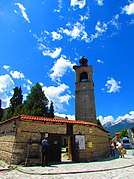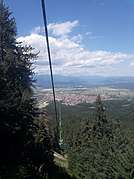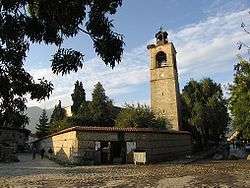Bansko
Bansko (Bulgarian: Банско) is a town in southwestern Bulgaria, located at the foot of the Pirin Mountains at an elevation of 1200m above sea level. It is a popular ski resort.
Bansko | |
|---|---|
.jpg)    .jpg)   Bansko | |
 Coat of arms | |
 Bansko Location of Bansko | |
| Coordinates: 41°50′N 23°30′E | |
| Country | Bulgaria |
| Province (Oblast) | Blagoevgrad |
| Government | |
| • Mayor | Georgi Ikonomov (GERB) |
| Elevation | 1,200 m (3,900 ft) |
| Population (01.02.2011) | |
| • Total | 8,562 |
| Time zone | UTC+2 (EET) |
| • Summer (DST) | UTC+3 (EEST) |
| Postal Code | 2770 |
| Area code(s) | 0749 |
| Website | www |
Legends
There are several legends about who founded Bansko. According to one, Bansko was founded by people who lived in Dobarsko, a village in Rila, itself, according to a legend, founded by the blinded army of Tsar Samuil. Another legend claims that Bansko was founded by an Italian painter by the name of Ciociolino, hence the existence of the name Chucholin in Bansko.
Still according to another version it was a Slavic tribe called the Peruns, who lived in Pirin and worshiped Perun, that founded the village later to become a town. There are a number of ethnographic texts, legends, prayers and oratories, which lend credence to this legend.
History
The archeological traces of the inhabitants of Bansko and the Razlog Valley in general date to the early periods of the Roman Empire. There are several housing structures at the outskirts of the town, which date to 100 BC. However, there is no consensus nor credible theory on who these people were.
Bansko, then part of the Byzantine (Eastern Roman) Empire was added to Bulgaria during the reign of Khan Krum, most probably around 811 AD, and passed back and forth between Byzantines and Bulgarians for the next few centuries, before control fell to the Ottomans in the 14th century.
Remains of an antique and medieval church have been found 2 kilometers southwest of the town, in the Shipotsko locality. It was built in the late IV or early 5th century, probably on an earlier Thracian structure, with a necropolis with over 150 graves developed around it. The ancient church was destroyed in the 6th century, rebuilt after the 12th century and again destroyed by the Ottomans.
In the XVIII-XIX centuries Bansko maintained lively relations with the Rila Monastery. There is a meth in the village where for some time the priest Joseph the Builder. Bansko pilgrimage groups donate generously to the monastery. In 1840 they received 4310 pennies. Molerov's Bansko painters are famous for their murals in the church and chapels of the monastery and the icons that make for it. Bansko supplies food for the brotherhood - beans, soap, olive oil and more. In 1852 the Banskali Todor erected an iron gift for the monastery in the village of Rila.
Around 1850, the Bansko Bulgarian Municipality was founded - an organization of local Bulgarian self-government, a continuation of the general village council formed in 1833, headed by Lazar German, to provide funds, materials and manpower for the construction and decoration of the Holy Trinity Church, consecrated in 1835. The municipality's leadership includes influential representatives of the trade and craft industry. In the 1860s and 1870s the municipality headed the struggle against the Greek ecclesiastical authorities for the independence of the Bulgarian church and for the development of enlightenment in the village. At her initiative, a new school building was built in 1857, the mutual school was reorganized into a classroom, and the Revival newspapers and books were distributed. The municipality organized the construction of the bell tower of Holy Trinity Church in 1850 and the installation of a clockwork in 1865.
According to testimonies of American missionaries who visited Bansko in 1867, it has 4 to 5 thousand Bulgarians who welcome them. In the 1970s, together with other Razlog municipalities, resisted the Protestant propaganda. The Bansko Bulgarian Municipality financially supports the families affected by the suppression of the Kresna-Razlog Uprising of 1878-1879 and the Ilinden-Transfiguration Uprising of 1903.
In the Ethnography of the Villanets of Adrianople, Monastir and Thessaloniki, published in Constantinople in 1878 and reflecting the statistics of the male population of 1873, Bransko is cited as a village with 798 households and 2,700 Bulgarians.
Georgi Strezov for Bansko (1891):
"Bansko, a palace larger than Mehomiya, on Yu 1 hour. The road is flat and wide. Bansko is situated on one hill; has a good look better than Mehomiya. The charshia is gone; Inns in Bansko have 5. Water is plentiful here; every street and stream, every time and the fountain. Most of the houses are stone and two storey. In the middle of the village stands a beautiful church of the Holy Trinity with a bell-shaped bell-tower. There is also a city clock made by a self-made engineer and machinist, T. H. Radonov. The school is not far from the church, a new huge building that could house up to a thousand students; the yard is wide. The teachers are 6 people with 300 students; girls' school, a little further away, with 2 teachers and up to 150 students. By 1887, the two schools were united, then they first separated and formed grades I and II during the time of teachers Samardzhiev and Boyanov. Protestants, about 50 houses, have their own school and prayer house.
The main occupation of the inhabitants is agriculture. The tobacco tablecloth, which was once in good condition, now seats 50 people in 3 tabakhans. There are all kinds of other craftsmen. Remarkable are the gigantic growth, the rugged structure, the ruddy appearance and the innate wit of the inhabitants. Many without any science have made wool factories, spinning machines and more. Carpenters are no less skilled. By its mild nature, the banskali are distinguished from other decompositions; the same difference is observed in speech. In Bansko and Belitsa there are rumors that there are people who are specifically involved in making money-making money; this craft was old in the place. Note that there are many skillful hardware stores. Carpentry is much advanced: coffins, chairs and more. products are distributed all over Macedonia and Bulgaria. Besides the said church, there is another old one at the cemetery. Houses 1200, Bulgarians only. "
According to the famous statistics of Vasil Kunchov (Macedonia. Ethnography and Statistics), Bansko is the largest settlement in Razlog, as of 1900. It is home to 6,500 Bulgarian Christians.
At the outbreak of the Balkan War in 1912, 131 people from Bansko volunteered in the Macedonian-Adrian militia. During the war, the municipality organized the gathering of food and clothing for the Bulgarian army and for the volunteer troops of the IMORO. Bansko was released on October 5, 1912 with the help of troops led by Yonko Vaptsarov, Hristo Chernopeev, Georgi Zankov, Mikhail Chakov, Peyo Yavorov, Stefan Chavdarov, Lazar Kolchagov and others. Two days later, voivode Peyo Yavorov congratulates the Banskali on being free [1]
Religion

The church "Sveta Troitsa" (Saint Trinity) is an Orthodox Christian church, part of Bulgarian Orthodox Church. It was built by the people of Bansko in 1835.
The Bulgarian Evangelical Church Community, the first Protestant church in Bulgaria, was founded in Bansko on 6 August 1868.[2]
Economy


Bansko, once mainly a stockbreeding and travelling merchant community, has become an international centre for winter and summer tourism. The mountain peaks near the town, the numerous lakes and the old pine woods make it a popular site for recreation. Bulgaria's share in European winter tourism is steadily rising, and Bansko increasingly competes with resorts in France and Switzerland due to the comparative lower costs but not in quality.[3] Improvements to the infrastructure and organisation of the ski area on Todorka have been made annually to accommodate the rising number of tourists. A gondola lift was built from town in 2003, replacing the minibus ride to the primary base area of Banderishka Poliana. As of 2010, the ski area has 75 km (47 mi) of ski runs, 14 lifts and drags,[4] serving up to 24,500 persons per hour.[5] The lift-served summit rises to an elevation of 2,600 m (8,500 ft) above sea level. The vertical drop is nearly 1,000 m (3,300 ft) to the base area at Banderishka Poliana, and over 1,600 m (5,200 ft) with the ski runs to town[6]
Nowadays Bansko is known as a popular destination for Digital Nomads. Coworking Bansko is a community of Digital Nomads that has two co-working locations in the north and south part of the town.
The nearby village of Banya, located only 5 km (3 mi) from the town, is known for its 27 thermal mineral springs.
The town is served by the scenic narrow gauge line from Septemvri to Dobrinishte. Regular bus connections are available to Sofia, Plovdiv, Blagoevgrad, Gotse Delchev, Razlog, among others.
Many of the infrastructure problems have been given attention to since 2009. The large portion of unfinished apartments are now being given attention as well. Due to the global recovery from the financial crisis and the more realistic pricing, apartments are attracting more buyers from across Europe.[7] In 2010 the resort recovered from the crisis and has seen record profits.
Climate
| Climate data for Bansko (2000-2014) | |||||||||||||
|---|---|---|---|---|---|---|---|---|---|---|---|---|---|
| Month | Jan | Feb | Mar | Apr | May | Jun | Jul | Aug | Sep | Oct | Nov | Dec | Year |
| Average high °C (°F) | 3.1 (37.6) |
5.5 (41.9) |
9.6 (49.3) |
15.7 (60.3) |
20.8 (69.4) |
23.9 (75.0) |
26.8 (80.2) |
26.9 (80.4) |
23.1 (73.6) |
17.2 (63.0) |
11.1 (52.0) |
5.3 (41.5) |
15.7 (60.3) |
| Daily mean °C (°F) | −1.6 (29.1) |
0.7 (33.3) |
4.3 (39.7) |
9.6 (49.3) |
14.5 (58.1) |
17.7 (63.9) |
20.2 (68.4) |
20.1 (68.2) |
16.1 (61.0) |
11.1 (52.0) |
6.4 (43.5) |
0.3 (32.5) |
10.0 (50.0) |
| Average low °C (°F) | −5.7 (21.7) |
−4.1 (24.6) |
−1.1 (30.0) |
3.5 (38.3) |
8.1 (46.6) |
11.2 (52.2) |
12.6 (54.7) |
12.3 (54.1) |
9.0 (48.2) |
5.1 (41.2) |
1.6 (34.9) |
−3.6 (25.5) |
4.1 (39.4) |
| Source: Stringmeteo.com | |||||||||||||
Historical Climate Data
| Climate data for Bansko (1931-1970), records 1926-1970 | |||||||||||||
|---|---|---|---|---|---|---|---|---|---|---|---|---|---|
| Month | Jan | Feb | Mar | Apr | May | Jun | Jul | Aug | Sep | Oct | Nov | Dec | Year |
| Record high °C (°F) | 11.4 (52.5) |
18.1 (64.6) |
26.5 (79.7) |
26.9 (80.4) |
30.5 (86.9) |
32 (90) |
34.1 (93.4) |
36.5 (97.7) |
34.4 (93.9) |
29 (84) |
22.3 (72.1) |
17.2 (63.0) |
36.5 (97.7) |
| Average high °C (°F) | 2.2 (36.0) |
4.7 (40.5) |
8.7 (47.7) |
14.8 (58.6) |
19.7 (67.5) |
23.1 (73.6) |
25.5 (77.9) |
25.8 (78.4) |
22.5 (72.5) |
16.5 (61.7) |
10 (50) |
4.7 (40.5) |
14.9 (58.8) |
| Daily mean °C (°F) | −1.9 (28.6) |
0 (32) |
3.4 (38.1) |
8.7 (47.7) |
13.3 (55.9) |
16.8 (62.2) |
18.9 (66.0) |
18.7 (65.7) |
14.7 (58.5) |
9.9 (49.8) |
5.2 (41.4) |
0.3 (32.5) |
9.3 (48.7) |
| Average low °C (°F) | −6.1 (21.0) |
−4.4 (24.1) |
−1.4 (29.5) |
2.9 (37.2) |
7.6 (45.7) |
10.5 (50.9) |
12 (54) |
11.7 (53.1) |
8.7 (47.7) |
4.6 (40.3) |
1.2 (34.2) |
−3.9 (25.0) |
3.6 (38.5) |
| Record low °C (°F) | −24.8 (−12.6) |
−19.3 (−2.7) |
−17 (1) |
−7.6 (18.3) |
−1.2 (29.8) |
1.4 (34.5) |
4.5 (40.1) |
3 (37) |
−3.5 (25.7) |
−5.9 (21.4) |
−13.4 (7.9) |
−17.6 (0.3) |
−24.8 (−12.6) |
| Average precipitation mm (inches) | 71 (2.8) |
59 (2.3) |
52 (2.0) |
56 (2.2) |
65 (2.6) |
57 (2.2) |
42 (1.7) |
31 (1.2) |
37 (1.5) |
65 (2.6) |
79 (3.1) |
80 (3.1) |
694 (27.3) |
| Source: Stringmeteo.com | |||||||||||||
Sport
Bansko has recently hosted FIS World Cup alpine ski races: the women raced in 2009 in two downhills and a super G.[8] The men's circuit made its first stop at Bansko in 2011 with a super combined and a slalom.[9][10] It hosted the men's giant slalom in February 2012 and the FIS World Cup ladies' downhill and super G,[11] and men's giant slalom and slalom.[12]
Alpine and biathlon competitions take place regularly. It is expected that the summer biathlon world cup will also take place in the resort of Bansko.
Events
In recent years, the town has gained international popularity as a pop and jazz scene after the start of the annual Bansko Jazz Festival and consequently the annual Bansko pop-star concert featuring top pop stars. In March the town hosts the British underground dance fete Horizon Festival.
Honour
Bansko Peak on Livingston Island in the South Shetland Islands, Antarctica is named after the town of Bansko.
International relations
Twin towns — sister cities
Bansko is twinned with:




Notable people
Notable people that were born or lived in Bansko include:
- Paisius of Hilendar (1722 - 1773), author of Istoriya Slavyanobolgarskaya
- Neofit Rilski (1793 - 1881), monk, teacher and artist
- Nikola Vaptsarov (1909 - 1942), poet and revolutionary
- Irina Nikulchina (born 1974), 2002 Winter Olympics bronze medal winner
See also
References
- "Банско", Уикипедия (in Bulgarian), 2019-10-04, retrieved 2019-10-21
- www.protestantstvo.com/show.php?id=35 Archived October 8, 2007, at the Wayback Machine
- Bulgaria's share of the skiing market is rising, The Sofia Echo, 2 December 2011
- Bansko Lift Status. Check Online Ski Runs And Lift Status In Bansko Resort
- banskoski.com
- banskoski.com Archived February 16, 2011, at the Wayback Machine - ski map - accessed 2011-02-26
- Irish Times.com - 2200 Irish own an apartment in Bansko - 2009-05-21
- FIS-ski.com - Bansko - World Cup events - 2009 - women
- FIS-ski.com - Bansko - World Cup events - 2011 - men
- Bansko World Cup.com - accessed 2010-02-26
- "AUDI FIS ALPINE SKI WORLD CUP 2011/12 LADIES (L)" (PDF). FIS Ski. Archived from the original (PDF) on 2011-11-25. Retrieved 2011-11-09.
- "AUDI FIS ALPINE SKI WORLD CUP 2011/12 MEN (M)" (PDF). FIS Ski. Archived from the original (PDF) on 2011-10-27. Retrieved 2011-11-09.

